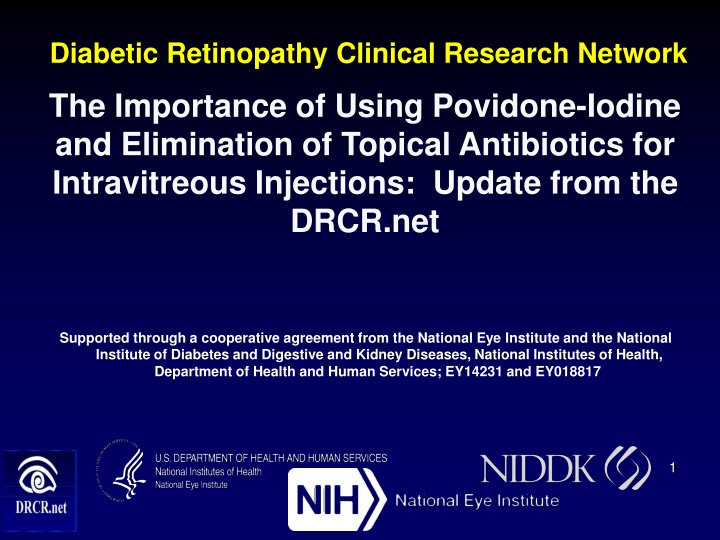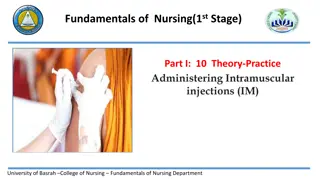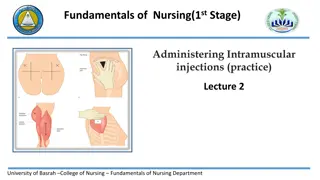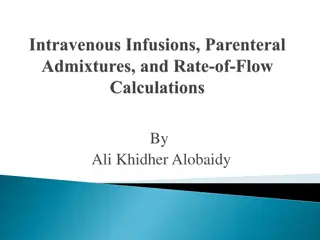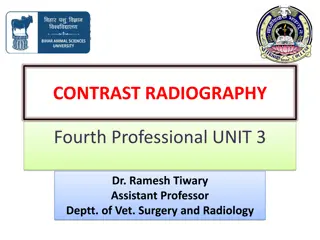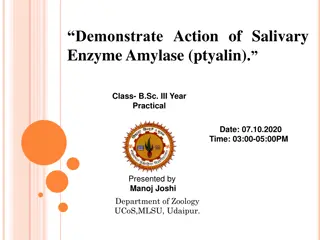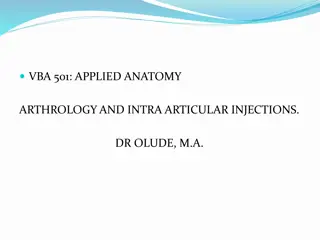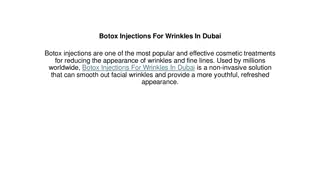Importance of Povidone-Iodine in Intravitreous Injections
Diabetic Retinopathy Clinical Research Network emphasizes the use of povidone-iodine and elimination of topical antibiotics for intravitreous injections to reduce endophthalmitis risk based on their research findings and standardized procedures. The update discusses the comparison of endophthalmitis rates with and without topical antibiotics in various clinical trials conducted by DRCR.net.
Download Presentation

Please find below an Image/Link to download the presentation.
The content on the website is provided AS IS for your information and personal use only. It may not be sold, licensed, or shared on other websites without obtaining consent from the author.If you encounter any issues during the download, it is possible that the publisher has removed the file from their server.
You are allowed to download the files provided on this website for personal or commercial use, subject to the condition that they are used lawfully. All files are the property of their respective owners.
The content on the website is provided AS IS for your information and personal use only. It may not be sold, licensed, or shared on other websites without obtaining consent from the author.
E N D
Presentation Transcript
Diabetic Retinopathy Clinical Research Network The Importance of Using Povidone-Iodine and Elimination of Topical Antibiotics for Intravitreous Injections: Update from the DRCR.net Supported through a cooperative agreement from the National Eye Institute and the National Institute of Diabetes and Digestive and Kidney Diseases, National Institutes of Health, Department of Health and Human Services; EY14231 and EY018817 1
Financial Disclosure DRCR.net: Principle Investigator, research funds Allergan: Advisory Board No relevant financial relationships for this presentation.
Background DRCR.net has previously reported low rates of endophthalmitis via a protocol requiring topical povidone-iodine, a sterile lid speculum, and topical anesthetic, but not requiring topical antibiotics, sterile gloves, or a sterile drape1,2 A total of 24,065 intravitreous injections have now been administered to 2,598 eyes across DRCR.net trials. 1. Bhavsar AR, Googe JM, Jr., Stockdale CR, et al. Risk of endophthalmitis after intravitreal drug injection when topical antibiotics are not required: the diabetic retinopathy clinical research network laser-ranibizumab-triamcinolone clinical trials. Arch Ophthalmol. 2009;127(12):1581-3. Bhavsar AR, Stockdale CR, Ferris FL III, et al. Update on Risk of Endophthalmitis After Intravitreal Drug Injections and Potential Impact of Elimination of Topical Antibiotics. Arch Ophthalmol. 2012;130(6):809-810. 2.
Purpose Update of a non-randomized comparison of endophthalmitis rates after intravitreal injection with and without use of topical antibiotics in six DRCR.net Trials: Phase II Bevacizumab for DME (Protocol H) Laser-Ranibizumab-Triamcinolone for DME (Protocol I) Laser-Ranibizumab-Triamcinolone for DME + PRP (Protocol J) Intravitreal Ranibizumab vs Saline for VH from PDR (Protocol N) Prompt PRP vs Ranibizumab+Deferred PRP for PDR (Protocol S) Aflibercept, Bevacizumab and Ranibizumab for DME (Protocol T) Treatment for CI-DME with Very Good VA Study (Protocol V) A new look at development of endophthalmitis without use of povidone-iodine 4
Standardized DRCR.net Injection Procedure Requires application of topical anesthetic drops or gel (sub-conjunctival injection discouraged) Requires use of a sterile eyelid speculum Requires application of topical povidone-iodine to conjunctiva Does not require topical antibiotics prior to, on day of, or after injection Does not require sterile gloves, sterile drape, or face mask Product was required to be drawn up by investigator from single-use vial at time of injection (bevacizumab, ranibizumab, aflibercept, saline) 5
Pre- and Post-Injection Antibiotic Use Number of Injections (%) No Pre-Injection and No Post- Injection Antibiotics Pre-Injection OR Post-Injection Antibiotics Number of Injections (%) 13608 (57%) 10,444 (43%) No Povidone Iodine 13 24,065 Total 6
Evolution of Antibiotic Use in DRCR.net Over Time 100% Yes (Pre- or Post-) No 80% 60% 40% 20% 0% 7 2006 2007 2008 2009 2010 2011 2012 2013 2014
Use of Povidone Iodine Use of pre-injection povidone-iodine is strictly required The procedure requires topical povidone-iodine allowed to be present for at least 30 seconds over the injection site, use of a sterile lid speculum, and topical anesthetic Omission of povidone-iodine is a protocol violation For eyes in which povidone-iodine cannot be used (e.g. allergy), study injections should not be given per protocol 8
Povidone-Iodine Use 24,065 Intravitreal Injections (2,598 eyes) 13 injections (2 eyes) without Povidone-Iodine (protocol violation) 15% of injections without Povidone-iodine developed endophthalmitis 9
Povidone-Iodine Use 24,065 Intravitreal Injections (2,598 eyes) 13 injections (2 eyes) without Povidone-Iodine (protocol violation) 100% of eyes developed endophthalmitis 10
Rates by Antibiotic Use 24,052* Intravitreal Injections (2,596 eyes) 9 Cases of Endophthalmitis 6 (0.06%) With 3 (0.02%) Without p = 0.19 Topical Antibiotics Topical Antibiotics *Excluding injections given without povidone iodine (13 injections in 2 eyes) 11
Cases of Endophthalmitis Case Intravitreal Product Injected Culture Results Povidone -Iodine Use Pre-op Antibiotic s Post-op Antibiotic s Coagulase negative staphylococcus Coagulase negative staphylococcus Culture negative Coagulase negative staphylococcus 1 Bevacizumab Yes No No 2 Ranibizumab Yes Yes Yes 3 Ranibizumab Yes No Yes 4 Ranibizumab No* Yes Yes * Since this event, the DRCR.net has clarified to participating investigators that no study injections may be performed without use of povidone-iodine over the injection site, even as a protocol deviation. 12
Cases of Endophthalmitis Intravitreal Product Injected Pre-op Antibiotic s Post-op Antibiotic s Povidone- Iodine Use Case Culture Results Streptococcus viridans Coagulase negative staphylococcus 5 Ranibizumab Yes No Yes 6 Ranibizumab Yes No Yes 7 Saline Culture negative Yes No Yes 8 Ranibizumab Culture negative Yes Yes Yes 13 Scant growth of methicillin resistant staphylococcus aureus also was reported.
Cases of Endophthalmitis Intravitreal Product Injected Pre-op Antibiotic s Post-op Antibiotic s Povidone- Iodine Use Case Culture Results Coagulase negative staphylococcus 9 Ranibizumab No* No No 10 Aflibercept Culture Negative Yes No No Staphylococcus epidermis 11 Bevacizumab Yes No No * Against DRCR.net policy, an injection was performed without povidone-iodine due to severe betadine allergic reaction experienced with prior injections (Shur-Clens was used for prep). 14
Discussion The standardized intravitreal injection protocol in the DRCR.net trials offers an opportunity to evaluate the role of topical antibiotics and povidone-iodine use on the risk of endophthalmitis following intravitreal injection As reported in multiple previous studies, a low rate of post-injection endophthalmitis has occurred in the DRCR.net trials Topical antibiotic use no longer is standard in a majority of injections given as part of Network protocol 15
Conclusions Not including topical povidone-iodine substantially increases the risk of endophthalmitis Current data suggest that it is extremely unlikely that omitting topical antibiotics prior to, on the day of, or after injection has a moderate or large increase on the risk of endophthalmitis 16
Thank You! 17
References 1. Bhavsar AR, Googe JM, Jr., Stockdale CR, et al. Risk of endophthalmitis after intravitreal drug injection when topical antibiotics are not required: the diabetic retinopathy clinical research network laser-ranibizumab- triamcinolone clinical trials. Arch Ophthalmol. 2009;127(12):1581-3. 2. Diabetic Retinopathy Clinical Research Network, Scott IU, Edwards A, et al. A phase II randomized clinical trial of intravitreal bevacizumab for diabetic macular edema. Ophthalmal. 2007;114(10):1860-7. 3. The Diabetic Retinopathy Clinical Research Network. Randomized trial evaluating ranibizumab plus prompt or deferred laser or triamcinolone plus prompt laser for diabetic macular edema. Ophthalmology. 2010;117(6):1064- 77 e35. 4. Googe J, Brucker AJ, Bressler NM, et al. Randomized trial evaluating short- term effects of intravitreal ranibizumab or triamcinolone acetonide on macular edema after focal/grid laser for diabetic macular edema in eyes also receiving panretinal photocoagulation. Retina. 2011;31(6):1009-27. 5. Diabetic Retinopathy Clinical Research Network. An Evaluation of Intravitreal Ranibizumab for Vitreous Hemorrhage Due to Proliferative Diabetic Retinopathy. http://drcrnet.jaeb.org/Studies.aspx?RecID=186. Accessed October 25, 2011. 18
